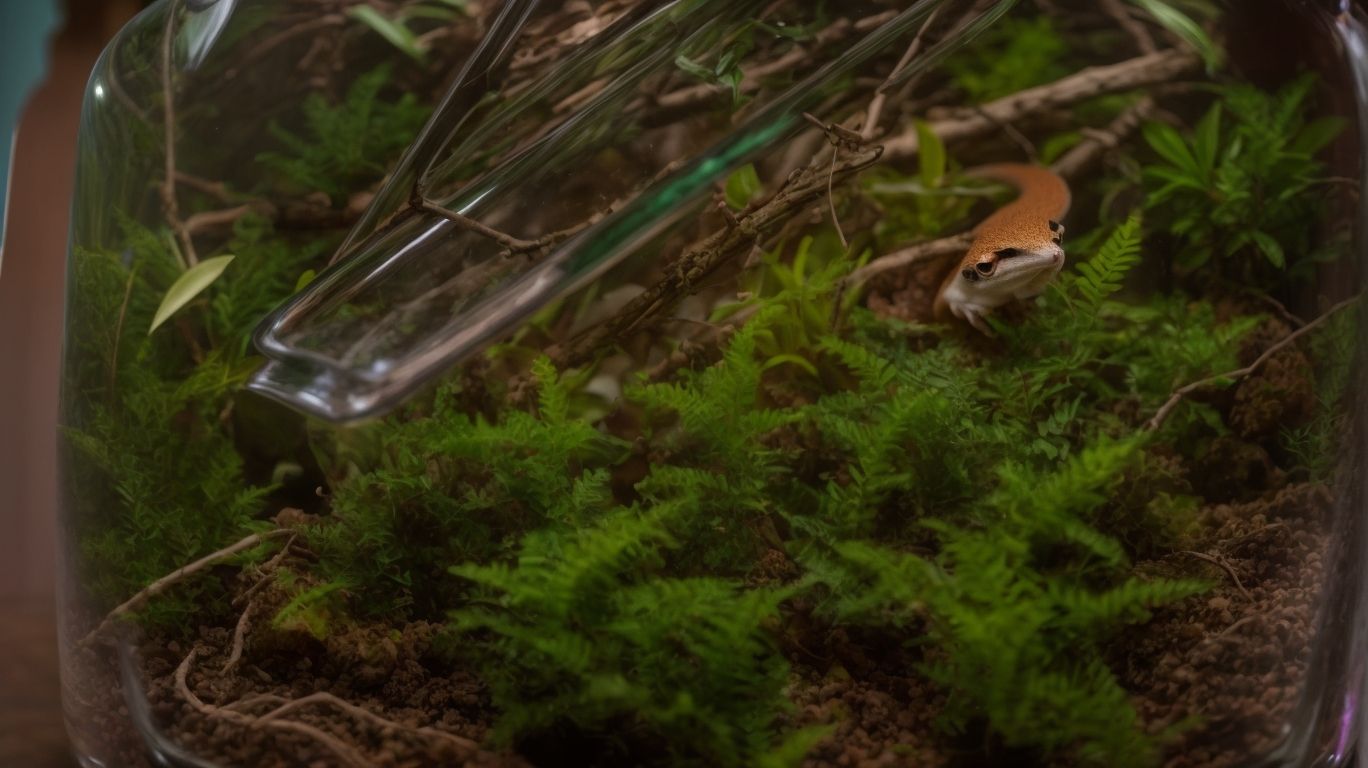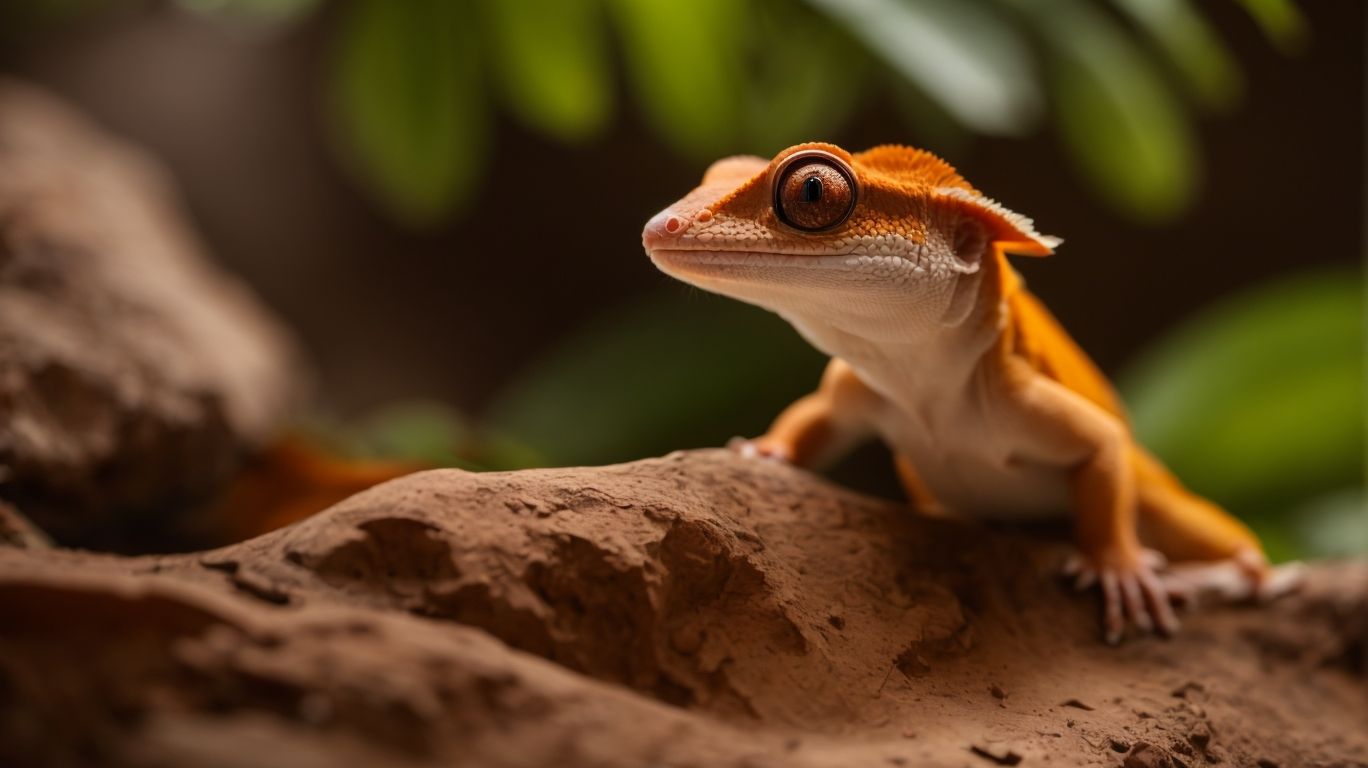
Creating the Perfect Breeding Environment for Crested Geckos
Are you interested in breeding crested geckos but not sure where to start? This article will provide you with all the information you need to create the ideal breeding environment for these fascinating reptiles.
From the basic needs of crested geckos to the common mistakes to avoid, we’ll cover everything you need to know to successfully breed these unique creatures. Whether you’re a seasoned gecko breeder or just starting out, this article has something for everyone. So, let’s dive in and learn how to create the perfect breeding environment for crested geckos!
What Are Crested Geckos?
Crested Geckos, scientifically known as Correlophus ciliatus, are a species of gecko native to southern New Caledonia. They are known for their distinctive crests, which run from their eyes to the tip of their tail.
Geckos are fascinating creatures with the unique ability to drop their tails as a defense mechanism, which will regenerate over time. They can be found in a variety of environments, from subtropical forests to semi-arid regions, showcasing their adaptability. Their diet consists of a combination of insects and fruits.
Females lay eggs every 4-5 weeks, and the hatchlings are surprisingly independent, able to hunt on their own within days. Their growth and development is rapid, with some geckos reaching sexual maturity within just one year.
What Are the Basic Needs of Crested Geckos?
Crested Geckos require a carefully curated habitat to thrive, including specific temperature and humidity levels, a balanced diet, access to calcium supplements, and a clean and reliable water source for hydration.
Maintaining the correct temperature and humidity is crucial in a Crested Gecko’s habitat, as they originate from tropical regions. It is advisable to keep the terrarium temperature between 72-78°F (22-26°C) during the day and slightly cooler at night.
Humidity levels should be maintained around 60-80%. A diet high in calcium is essential for their bone health, and providing a water source that is regularly cleaned and refreshed is important for their overall well-being.
Proper Enclosure
Creating the perfect enclosure for Crested Geckos involves selecting suitable substrate, ensuring proper ventilation, and providing sufficient space for the geckos to explore and thrive.
The design of the enclosure plays a crucial role in simulating the natural habitat of Crested Geckos. The right materials are essential for creating a comfortable and safe environment.
Ventilation is necessary to maintain proper air circulation and humidity levels. A spacious enclosure allows the geckos to engage in natural behaviors and ample space for climbing and exercising.
The use of appropriate substrate, such as coconut husk or eco earth, contributes to a healthy environment and aids in maintaining optimal humidity levels within the enclosure.
Appropriate Temperature and Humidity Levels
Maintaining appropriate temperature and humidity levels within the gecko’s terrarium is crucial to replicating their natural environment and ensuring their well-being. Regular monitoring is essential to achieve this balance.
This balance is vital for the gecko’s health and overall behavior. Inadequate temperature and humidity can lead to stress, lethargy, or even health issues.
It’s important to invest in quality monitoring equipment such as thermometers and hygrometers to keep a close eye on the terrarium conditions. By implementing a consistent monitoring routine, you can make timely adjustments, ensuring a comfortable and thriving habitat for your gecko. These efforts contribute to the overall happiness and longevity of your pet.
Nutritious Diet
A nutritious diet for Crested Geckos should include a variety of appropriately sized insects, along with fruit-based commercial diets, and must adhere to a consistent feeding schedule. Gut loading the insects enhances their nutritional value.
This ensures that the geckos receive a balanced intake of protein, vitamins, and minerals crucial for their growth and overall health.
Fruit-based commercial diets can serve as a convenient and balanced source of essential nutrients. Supplementing them with live insects is vital to mimic their natural diet in the wild.
Gut-loading insects involves feeding them nutritious foods, such as fresh fruits and vegetables, to increase their nutrient content before being offered to the geckos, ensuring they receive optimal nutrition.
Clean Water and Hydration
Crested Geckos must have access to clean water at all times, provided through misting to create necessary moisture. Regular maintenance of the water source is essential to ensure proper hydration for the geckos.
It is crucial to monitor the humidity levels within the gecko’s habitat, as they thrive in environments with 60-80% humidity. Misting the terrarium 1-2 times a day helps maintain the required moisture levels, simulating the natural conditions of their native rainforest habitats. In addition to misting, a shallow water dish should be available for drinking and soaking. Adequate hydration not only supports their health and well-being but also contributes to the overall vitality and vibrancy of these captivating creatures.
What Is the Ideal Breeding Environment for Crested Geckos?
Creating the ideal breeding environment for Crested Geckos involves understanding their reproductive behavior, providing suitable nesting and egg-laying areas, and sourcing a compatible breeding pair for successful reproduction.
Understanding the reproductive behavior of Crested Geckos is crucial for creating a conducive breeding environment. This includes recognizing their mating displays, understanding territorial behaviors, and identifying signs of receptive females.
Providing appropriate nesting and egg-laying areas is essential for successful reproduction, with options such as laying boxes or artificial platforms. Sourcing a compatible breeding pair involves considering genetic diversity, health, and temperament, as these factors significantly impact the success of breeding programs. Timing the breeding season in line with the natural cycle of Crested Geckos is pivotal for encouraging mating behavior and successful egg incubation.
Size and Type of Enclosure
The size and type of the enclosure for breeding Crested Geckos should allow ample space for the mating pair, and support the growth of offspring. It should also meet the requirements for the geckos’ breeding age.
A suitable enclosure for Crested Geckos should have a vertical design to accommodate their arboreal nature. Young geckos need smaller enclosures to prevent stress and promote feeding, while adults may require more significant space.
It’s essential to provide various ledges and branches for climbing, ensuring they can exercise and shed properly. The enclosure should also maintain proper humidity levels and temperature gradients, crucial for the breeding age of the geckos. Choosing the right enclosure plays a crucial role in ensuring a successful breeding environment for Crested Geckos.
Temperature and Humidity Requirements
Maintaining precise temperature and humidity levels during the incubation period is crucial for successful egg development and hatching of baby Crested Geckos. These conditions closely mimic their natural habitat.
Creating an environment that mimics the geckos’ natural surroundings is crucial for their growth and health during the incubation period. This involves regulating the temperature between 72-80°F and maintaining humidity at 80-100%.
By replicating the natural climate, the embryonic development is supported, increasing the chances of successful hatching and ensuring the baby geckos’ smooth transition into a thriving habitat.
Nesting and Egg-Laying Areas
Providing suitable nesting and egg-laying areas within the gecko’s terrarium, along with appropriate plants for cover and climbing surfaces, is essential to facilitate natural breeding behaviors and egg incubation.
This ensures that the geckos have a conducive environment for their reproductive activities and helps maintain their natural instincts. Proper nesting areas provide a secure space for egg deposition, promoting the health and safety of the eggs.
Plants not only offer hiding spots but also act as climbing surfaces, encouraging physical activity and natural behaviors. When selecting plants for the terrarium, it is crucial to choose non-toxic species that can withstand the gecko’s movement and provide adequate coverage for privacy and security.
Proper Lighting and Substrate
The use of appropriate lighting, including UVB sources, and substrate selection that promotes environmental enrichment, is vital to create a favorable breeding environment for Crested Geckos. This ensures the well-being of the mating pair and offspring.
Proper lighting, especially UVB sources, plays a crucial role in providing the necessary light spectrum for the geckos’ overall health and breeding behavior.
Selecting suitable substrates that mimic their natural habitat contributes to their physical and mental well-being.
Environmental enrichment, such as climbing structures and live plants, offers opportunities for natural behaviors, reducing stress and enhancing their quality of life.
These elements create a harmonious breeding environment, fostering successful mating, egg development, and the healthy growth of offspring.
How to Create the Perfect Breeding Environment for Crested Geckos?
Creating the perfect breeding environment for Crested Geckos involves understanding their mating behavior, facilitating courtship rituals, providing suitable conditions for egg-laying, and carefully monitoring the incubation period.
Mating behavior among Crested Geckos often involves the male displaying territorial behavior, such as head bobbing and vocalization, to attract a potential mate.
During courtship rituals, the male may also perform a gentle swaying or circling motion to woo the female.
Once the female is gravid, she seeks out a suitable site for laying her eggs, often preferring dark, secluded areas.
The incubation period is critical, as maintaining optimal temperature and humidity levels is essential for the healthy development of the embryos.
Set Up the Enclosure
Setting up the enclosure for breeding Crested Geckos demands meticulous attention to cleanliness and hygiene to create a safe and conducive environment for successful mating, egg-laying, and hatching.
To ensure the health and reproductive success of Crested Geckos, it’s important to regularly clean their enclosure. This includes removing waste, debris, and uneaten food to prevent the buildup of harmful bacteria and parasites.
The habitat should also maintain optimal humidity and temperature levels to support the geckos’ reproductive behaviors. It’s essential to provide clean water sources and regularly sanitize feeding and watering dishes to prevent the spread of diseases.
Maintaining a well-ventilated environment with proper substrate and hiding spaces is also crucial. This helps reduce stress and promotes the overall health and reproductive success of Crested Geckos.
Monitor Temperature and Humidity Levels
To optimize readability and SEO, it’s advisable to break paragraphs into concise, easily digestible sentences. Add
tags to the text given and aim for a maximum of two sentences per
tag section, allowing multiple
tags. This approach enhances user experience and search engine indexing. Also, add tags to important keywords and phrases, and
tags for quotes.
Regularly monitoring the temperature and humidity levels, along with ensuring proper ventilation, is essential to create an environment conducive to successful breeding and optimal offspring development for Crested Geckos.
Maintaining stable temperature and humidity levels is crucial for the overall well-being of the geckos. Consistent monitoring allows the keeper to make timely adjustments to ensure the parameters remain within the desired range.
Inadequate ventilation can lead to the buildup of harmful gases and moisture, which can cause respiratory issues and mold growth. Efficient ventilation helps in regulating airflow, preventing heat pockets, and ensuring a healthy and comfortable environment for the geckos.
Provide Proper Nutrition and Hydration
Ensuring proper nutrition, a reliable water source, and appropriate supplementation through a balanced feeding schedule is crucial for the breeding pair’s health and the development of healthy offspring for Crested Geckos.
A well-rounded diet is crucial for the breeding pair, including a variety of insects that are gut-loaded with essential nutrients like calcium and vitamin D3. This supports their overall health and egg development. It’s important to maintain a consistent feeding schedule to ensure they receive these necessary nutrients regularly.
In terms of hydration, providing a shallow water dish or misting the enclosure can help meet their needs. Additionally, supplementing their diet with calcium and multivitamins can further support their reproductive health and overall well-being.
Monitor Breeding Behavior and Egg-Laying
Closely monitoring the breeding behavior, egg incubation, and subsequent care for the offspring is essential for successful breeding and ensuring the well-being of the mating pair and the new baby Crested Geckos.
This level of attentive monitoring during the mating process allows for the timely intervention if any issues arise, ensuring the proper development of the eggs and the health of the adult geckos.
Egg incubation requires consistent temperature and humidity control to support proper development. Once hatched, the newborns need a carefully controlled environment with adequate food and shelter to thrive.
Through careful observation and maintenance, breeders can help foster healthy mating behaviors and provide the best possible start for the Crested Gecko offspring.
What Are the Common Mistakes to Avoid in Breeding Crested Geckos?
To optimize readability and SEO, it’s advisable to break paragraphs into concise, easily digestible sentences. Add
tags to the text given and aim for a maximum of two sentences per
tag section, allowing multiple
tags. This approach enhances user experience and search engine indexing. Also, add tags to important keywords and phrases, and tags for quotes.
Avoiding common mistakes in breeding Crested Geckos involves meticulous maintenance, adherence to quarantine protocols for new geckos, protection from potential predators, and upholding the principles of responsible ownership.
This translates to ensuring the enclosure is clean, providing a well-balanced diet, and monitoring temperature and humidity levels. New geckos should undergo thorough quarantine to prevent the spread of diseases.
Predator prevention entails securing the enclosure to avoid escapes and keeping other pets away. Responsible ownership practices include thorough research, commitment to lifelong care, and not overbreeding to prevent overpopulation.
Improper Enclosure Size and Type
Choosing an enclosure that is too small or lacks adequate ventilation can lead to stress and health issues for Crested Geckos, making it crucial to prioritize sufficient space and proper airflow.
Inadequate space can cause geckos to feel cramped and anxious, leading to stress-related behaviors, such as decreased appetite and decreased activity.
Poor ventilation can result in stagnant air, creating an unsuitable environment for these creatures. Insufficient airflow may also lead to undesirable humidity levels, which can impact their respiratory health.
It’s essential to consider the gecko’s natural habitat and provide an enclosure that allows them to exhibit natural behaviors while ensuring proper ventilation.
Inconsistent Temperature and Humidity Levels
Inconsistencies in maintaining optimal temperature and humidity levels, often resulting from inadequate monitoring and cleanliness, can disrupt the breeding environment and endanger the well-being of Crested Geckos and their offspring.
This can negatively impact the development of eggs, hatchling health, and overall breeding success. It is crucial to establish a stringent hygiene routine to prevent the build-up of harmful bacteria and contaminants in the gecko habitat.
Regular cleaning of enclosures, removing uneaten food, and replacing substrate is essential. Employing accurate monitoring devices and thermometers can ensure that the temperature and humidity stay within the recommended ranges, promoting a healthy and thriving environment for Crested Geckos.
Lack of Proper Nutrition and Hydration
Neglecting the dietary and hydration needs of breeding Crested Geckos, including inadequate supplementation and irregular feeding schedules, can lead to health complications for the geckos and hinder successful reproduction.
This can result in deficiencies of essential nutrients such as calcium and vitamins, which are crucial for bone health and overall well-being.
Inadequate hydration can lead to dehydration, impacting the geckos’ metabolism and reproductive processes.
It’s important to ensure that the breeding pair receives a balanced diet with proper supplementation to support their nutritional requirements and maintain optimal health.
Establishing a consistent feeding schedule will also help regulate their digestive systems and provide the energy they need for successful breeding.
Not Monitoring Breeding Behavior and Egg-Laying
Failure to actively monitor breeding behavior, egg-laying, and post-hatching care can lead to missed opportunities for intervention and support, impacting the success of breeding and the well-being of the geckos and their offspring.
When breeding geckos, it’s essential to closely observe their mating behavior and monitor the egg-laying process for any difficulties or abnormalities. This proactive approach allows for timely intervention to address any issues that may arise.
Vigilant monitoring during post-hatching care is also crucial to ensure the well-being of both the geckos and their offspring. This includes identifying and addressing any potential problems, such as inadequate parental care or health complications in the young geckos.
By maintaining a proactive approach throughout the breeding process, breeders can greatly increase the chances of successful reproduction and promote the overall welfare of the geckos and their young.




No Comments